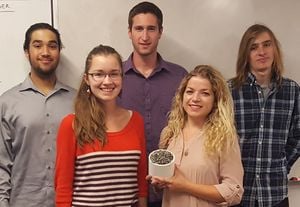No edit summary |
|||
| Line 68: | Line 68: | ||
|- | |- | ||
| Cement | | Cement | ||
| | | 20 47lbs bags | ||
| $ | | $ | ||
| $ | | $ | ||
|- | |- | ||
| | | Bender Board Lining | ||
| 120ft | | 120ft | ||
| $ | | $20.49 | ||
| $ | | $65.00 | ||
|- | |||
| Stakes | |||
| 2 bags of 10 | |||
| $11.99 | |||
| $25.00 | |||
|- | |- | ||
| Shovels | | Shovels | ||
| | | 5 | ||
| Donated | | Donated | ||
| Donated | | Donated | ||
| Line 100: | Line 105: | ||
| | | | ||
| | | | ||
| | | | ||
|} | |} | ||
See [[Help:Tables]] and [[Help:Table examples]] for more. | See [[Help:Tables]] and [[Help:Table examples]] for more. | ||
Revision as of 00:27, 1 May 2016

Abstract
The Eco Team designed and built a semi permeable walkway for our client at Zane Middle School. They needed a pathway that will drain well, keep students from walking through the parking lot, and will withstand high foot traffic. We started by evaluating different materials that could be used to build a walkway. The constraints for building materials we considered were safety, cost, environmental impact, drainage and aesthetics.

Introduction
The Eco team consists of five engineering students from Humboldt State University. Our names are McKenna Rayburn, Natalie Rynne, Jack Lisin, Shane Dotterer, and Makyle Harman. We are all students in Engineering 215 at Humboldt State University. Engineering 215 is Introduction to Design for Environmental Resources Engineering majors. Each semester, this class works with a client to design something for them.
Our Client is Zane Middle School in Eureka, CA. Our class was presented with a list of ideas that staff at Zane wanted for their school. Each group got to pick their favorite idea, and our group is building a semipermeable path in the front of the school. The staff of Zane Middle School want a pathway built in hopes that students will walk on the path instead of cutting through the school parking lot.
Understanding the Project Purpose
In front of the school there is a native garden that was planted by previous engineering 215 students. Next to the existing pathway is the undeveloped area that student walk through and track mud around from. Students walk through this area and the parking lot because it is a more direct route to the entrance of the school. The staff would like us to build a pathway where the students keep walking so they will not walk in the parking lot and the sidewalks will stay cleaner. This pathway will be next to the native garden.
Project goals
Our goals for our pathway are to create a safe, durable walkway so that less students will walk in the parking lot. We wanted to optimize the durability of our pathway without sacrificing permeability. Using 3/8" crushed gravel and specific ratios of cement mix and water, our pathway should withstand heavy foot traffic and drain water well. Other benefits of this pathway is that snow and ice will melt faster due to the air pockets between the crushed gravel that allow water to drain through easily. Our goal is that the school will be happy with the new pathway and it will make the front entrance look nicer.
Design
Describe your design here.
- Sample gallery
-
Digging out our pathway.
-
McKenna leveling the ground.
-
The Eco team getting ready to start paving.
-
Partially dried and touched up pathway.
-
The freshly paved permeable pathway.
Description of Final Project
After lengthy research, we found that gravel with cement mix was our best option. It is the cheapest and most environmentally friendly option that best fulfills the criteria we were given. We used Pyrex baking dishes to create samples to test different ratios of water to the cement mix and gravel. The Pyrex dishes worked so well we decided to use them as the mold for the rest of our pathway.
Materials and Costs
Cement mix is the most expensive component of our project. We were able to reduce costs significantly by using a friend's truck to transport the gravel rather than have it delivered.
| Material | Quantity | Cost | Total |
|---|---|---|---|
| Pea Gravel | 2 cu yd | $13.00 per ton | $36.00 |
| Delivery of Gravel | 1 | Donated | Donated |
| Cement | 20 47lbs bags | $ | $ |
| Bender Board Lining | 120ft | $20.49 | $65.00 |
| Stakes | 2 bags of 10 | $11.99 | $25.00 |
| Shovels | 5 | Donated | Donated |
| Wheel Barrow | 1 | Donated | Donated |
| Cement Mixer | 1 | Donated | Donated |
| Work Gloves | 5 | Donated | Donated |
| Total Cost |
See Help:Tables and Help:Table examples for more.
Discussion
Your discussion.
Next steps
The next steps.
Conclusions
Your conclusions.




